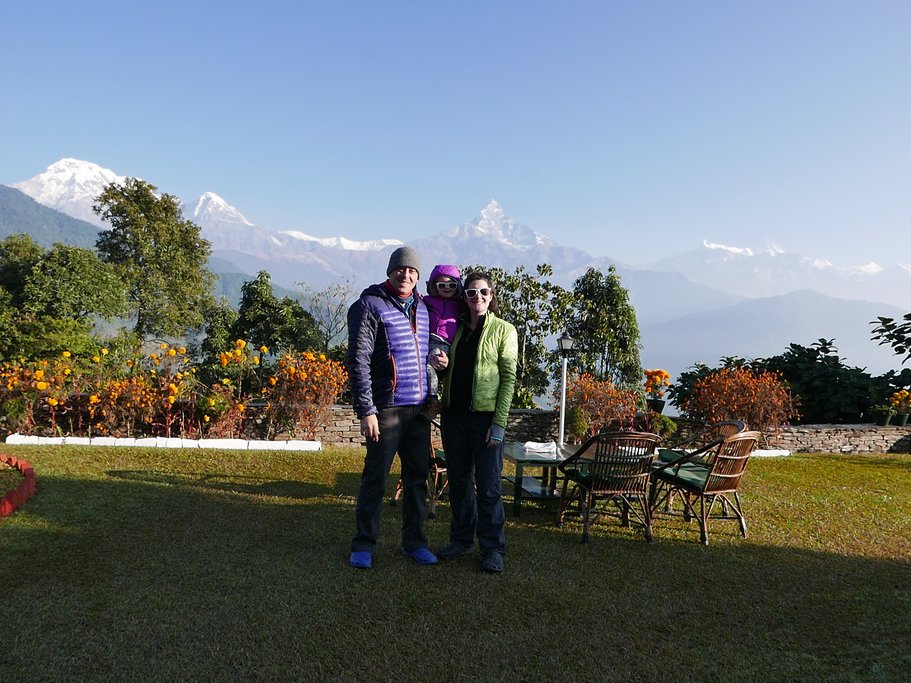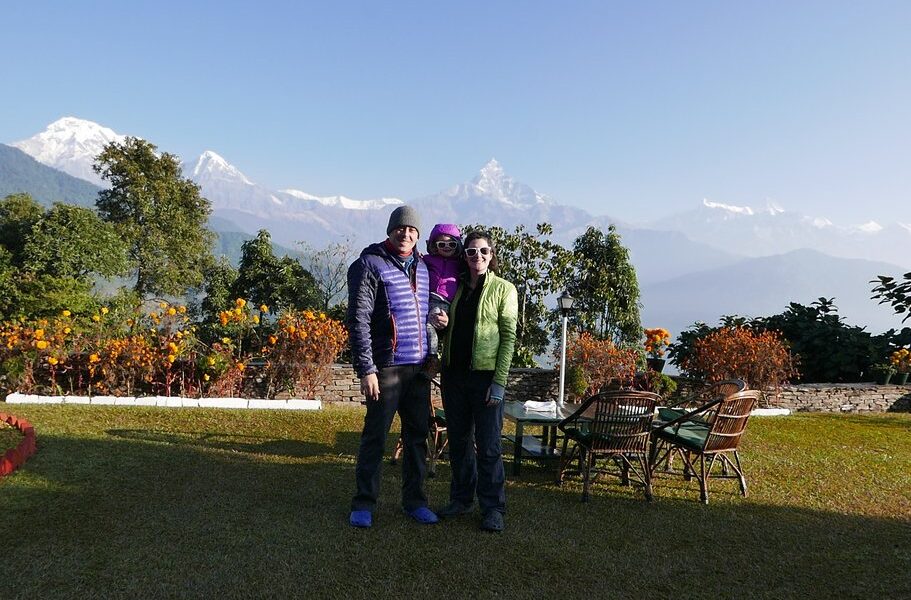
Families with young children may wonder if Nepal is a travel destination they should even consider, since it’s not your typical kid-friendly choice. At Big Time Holidays, we’ve put together several treks and mixed adventures for families with children, and by sharing their experiences, we hope we can help you decide if Nepal is right for your family.
For this interview, we had the distinct pleasure of speaking with a remarkable family hailing from the United States, a family that embarked on an unforgettable adventure with their vibrant 2-year-old child. Their journey included a captivating 5-day trek through the breathtaking landscapes of Nepal, followed by an enriching exploration of the renowned Chitwan National Park, a sanctuary teeming with diverse wildlife and natural beauty.
**Tell us a little bit about yourself and your family. Where are you from / where do you live? What do you do?**
The couple, both in their early thirties, shared their story with us. They are the proud parents of a delightful 2-year-old daughter, the apple of their eye. In May of 2016, they made a significant move, relocating from Connecticut to the vibrant and culturally rich southern region of India. Their plan is to immerse themselves in the Indian experience for a period of two years, embracing the opportunities and adventures that this new chapter offers. The husband works diligently in the ever-evolving field of technology, while the wife, prior to the joyous arrival of their daughter, dedicated her skills to the world of recruitment. With the arrival of their daughter, she made the loving decision to become a full-time caregiver, devoting her time and energy to nurturing and raising their child. Travel has always been an integral part of their lives, a shared passion that fuels their desire to explore the world. Their current location in India provides them with a unique advantage, granting them relatively easy access to an array of truly unique and captivating destinations, sparking their adventurous spirits and igniting their wanderlust.
**What kind of travel experiences have you had prior to this trip with your family? Did you do other adventurous trips before?**
Reflecting on their past adventures, the family shared a glimpse into their travel history. Since establishing their temporary home in India, they have ventured to several fascinating locales, including the bustling metropolis of Hong Kong, the serene island nation of Sri Lanka, the lush landscapes of Kerala, the sun-kissed beaches of Goa, and the iconic city of London. Before their move to India, their travel experiences included memorable ski trips out West, exploring the snowy slopes of Utah, Wyoming, and Montana. They also enjoyed skiing in the northeast, visiting the picturesque mountains of Vermont, upstate New York, and Maine. Furthermore, they indulged in relaxing vacations in the Caribbean, soaking up the sun and enjoying the turquoise waters, and explored the historical and cultural wonders of Europe.
They have always been drawn to incorporating an element of adventure into their trips, seeking out experiences that push their boundaries and create lasting memories. This includes such exciting activities as renting a pickup truck and embarking on a journey through the vibrant country of Guatemala, snowmobiling through the breathtaking landscapes of Yellowstone National Park, and skiing down the challenging slopes of various mountain ranges. However, they consider their trek in Nepal to be perhaps their most adventurous undertaking to date, given the demanding physical requirements, the extended length of the trek, and the remote and untamed nature of the location.
**How did you decide on Nepal as a destination? It’s probably more on the adventurous end of the spectrum for things you can do with young kids?**
When asked about their decision to choose Nepal as their destination, the couple explained that they both share a deep love and appreciation for the mountains. They reasoned that their current location in India presented a unique opportunity, as it was likely the only time in their lives that Nepal would be so easily accessible to them. Considering this, they felt compelled to seize the moment and embark on this incredible adventure. Furthermore, they believed that their daughter was at the perfect age for a trip of this nature. She was old enough to possess a certain level of self-sufficiency, yet young enough that they could still comfortably carry her in a child carrier, ensuring her safety and comfort throughout the trek. Additionally, they were planning to expand their family, with the wife currently three months pregnant. They recognized that traveling with two children would undoubtedly present greater challenges, making this the ideal time to undertake such an ambitious journey.
Despite traveling with their young daughter, they have consistently strived to maintain an element of adventure in their travel experiences. By taking the necessary precautions and carefully planning their itineraries, they have discovered that their daughter is remarkably adaptable to different countries, diverse climates, and interactions with various people. As long as she has access to regular meals, opportunities for naps, and the comfort of falling asleep with her parents at night, she seems content and unfazed by her surroundings, regardless of their location in the world.
They realized that the only factor truly holding them back from pursuing these types of experiences was the level of effort and commitment that they, as parents, were willing to invest in the trip. Traveling with a child can often present logistical challenges and, at times, create momentarily stressful situations. However, as long as the benefits and rewards of the experience outweigh the challenges and difficulties, there is little to prevent them from embarking on these extraordinary adventures.
**Did you have any specific concerns ahead of your trip? Any specific preparations?**
The family readily acknowledged that they had indeed harbored specific concerns leading up to their trip to Nepal. Consequently, they undertook meticulous preparations to address these concerns and ensure a safe and enjoyable journey for everyone.
Their primary concerns revolved around three key aspects:
1. Access to clean drinking water and safe food sources throughout their trek and stay in Nepal. They understood the importance of maintaining proper hydration and nourishment, especially for their young daughter.
2. The availability of suitable lodging options that would provide adequate protection from the elements. They specifically sought out lodges that offered a comfortable and secure environment, eliminating the need for pitching tents on potentially exposed mountain terrain.
3. The altitude and the potential risk of altitude sickness. They wanted to ensure that their itinerary was carefully planned to avoid any rapid ascents to high altitudes, minimizing the risk of altitude-related health issues for themselves and their daughter.
Kimkim played a pivotal role in addressing these concerns, providing invaluable assistance and support throughout the planning process. Ngima, a knowledgeable and experienced local expert, meticulously crafted an itinerary that perfectly aligned with their needs and preferences. In addition, to enhance the comfort and convenience of the trek for both the daughter and the parents, they invested in an Osprey Poco AG child carrier. This specialized carrier was equipped with a water bladder, ensuring that they always had easy access to fresh drinking water, a crucial element for staying hydrated during their physical activities.
**How was your arrival and stay in Kathmandu? It’s a busy, hectic city. Do you have any tips for travelers who plan on taking their young children to Kathmandu?**
The family shared their impressions of Kathmandu, acknowledging its reputation as a bustling and energetic city. However, having already spent six months living in India, they found that the sights and sounds of Kathmandu were not particularly overwhelming or jarring. Their primary concern centered on the dusty conditions of the roads and the less-than-ideal air quality in certain areas of the city. To mitigate these concerns, they limited their time spent in the city, primarily using it as a transit point to and from the airport. During these brief periods, they simply requested that their drivers keep the car windows rolled up, minimizing their exposure to the dust and air pollution. Their stay at the Gokarna Forest Resort proved to be a delightful escape from the urban environment. The resort’s tranquil setting and lush surroundings made them feel as though they were far removed from the city’s hustle and bustle, providing a welcome respite and a peaceful atmosphere.
**What parts of your stay in Nepal did you enjoy most? Were there any challenging parts? Did your child have any favorite places, days, and/or experiences?**
When asked about the highlights of their stay in Nepal, the family enthusiastically described the incredible views that surrounded them throughout their trek. The majestic mountains, the rolling hills, and the verdant valleys exceeded their expectations, leaving them in awe of the natural beauty of the region. However, they also expressed a deep appreciation for the opportunity to walk through the small, remote villages, each housing only around 20 to 30 people. They were profoundly impressed by the self-sufficiency of the villagers, witnessing firsthand how they were able to farm the land, raise animals, and protect themselves from the elements in such an isolated environment. The family found this experience to be both humbling and inspiring, gaining a newfound respect for the resilience and resourcefulness of the human spirit. The most challenging part of their trek occurred on Day 2, when they faced a steep ascent, climbing approximately 2,800 feet (853 meters) over a span of 7 to 8 hours. While the scenery was breathtaking, the physical demands of the climb were considerable, testing their endurance and determination. As for their daughter, her favorite part of the trip was undoubtedly the opportunity to identify and observe the various animals they encountered as they walked through the villages. For her, the trek transformed into a captivating safari, filled with exciting sightings of chickens, goats, cats, buffalo, cows, dogs, birds, and other creatures, igniting her curiosity and sparking her imagination.
**Was there anything unexpected about the experience? Anything you’d wish you knew in advance?**
The family felt that they had prepared thoroughly for their trip, leaving little room for unexpected surprises. However, they did express a minor concern about the potential for their daughter to have an abundance of energy at the end of each day, given that she was being carried for 4 to 8 hours at a time. They also noted that the “vertical” terrain of the trek presented limited opportunities for her to run around and expend her energy. Fortunately, their daughter proved to be just as tired as they were at the end of each day, likely due to the combined effects of being in the sun for extended periods and being constantly stimulated by her exciting surroundings.
**Do you have any tips for people who are considering taking their kids on a trek?**
Offering advice to other families considering a similar adventure, the couple shared their experience with choosing the right child carrier. They recounted a brief debate they had about whether to invest in the more robust Osprey child carrier or opt for a lighter, Baby-Bjorn-like carrier. Ultimately, they were extremely pleased with their decision to go with the Osprey, as the Baby-Bjorn would have been significantly less comfortable for both the child and the parents. The extra weight of the Osprey was well worth it, as it provided ample storage space for additional clothing layers, snacks, water, and a sunshade that effectively protected their daughter from the harsh rays of the sun. They now plan to continue using the Osprey child carrier on future trips, recognizing its value as a versatile and essential piece of travel equipment.
B-1790

